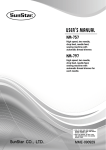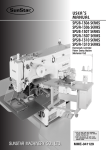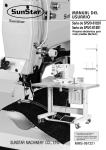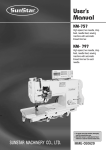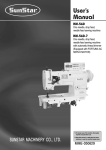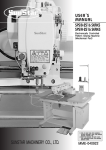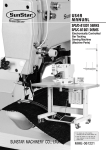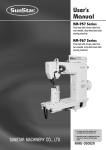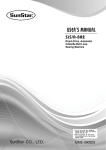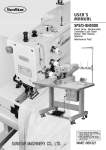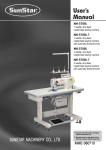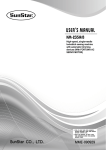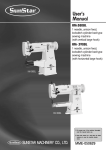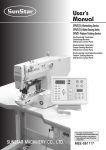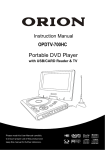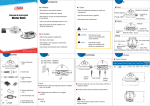Download User`s Manual
Transcript
R User’s Manual SPS/E-1306 Series SPS/E-1507 Series Electronically Controlled Pattern Sewing Machine (Mechanical Part) SUNSTAR MACHINERY CO., LTD. 1) FOR AT MOST USE WITH EASINESS, PLEASE CERTAINLY READ THIS MANUAL BEFORE STARTING USE. 2) KEEP THIS MANUAL IN SAFE PLACE FOR REFERENCE WHEN THE MACHINE BREAKS DOWN. MME-061207 lity a u tQ Besst Pricevice Be st Ser Be 1. Thank you for purchasing our product. Based on the rich expertise and experience accumulated in industrial sewing machine production, SUNSTAR will manufacture industrial sewing machines, which deliver more diverse functions, high performance, powerful operation, enhanced durability, and more sophisticated design to meet a number of user’s needs. 2. Please read this user’s manual thoroughly before using the machine. Make sure to properly use the machine to enjoy its full performance. 3. The specifications of the machine are subject to change, aimed to enhance product performance, without prior notice. 4. This product is designed, manufactured, and sold as an industrial sewing machine. It should not be used for other than industrial purpose. R SUNSTAR MACHINERY CO., LTD. Contents 1. MACHINE TYPE AND SPECIFICATIONS ............................................................ 6 1.1) Machine type .......................................................................................................... 6 1.2) Specifications of the machine .............................................................................. 7 2. SAFETY RULES ......................................................................................................... 8 2.1) Safety Stickers ....................................................................................................... 8 2.2) Machine Delivery ................................................................................................... 9 2.3) Machine Installation ............................................................................................ 10 2.4) Machine Operation .............................................................................................. 10 2.5) Repair and Maintenance .................................................................................... 11 2.6) Devices for Safety ............................................................................................... 11 2.7) Location of Safety Labels ................................................................................... 12 2.8) Type of Safety Labels ......................................................................................... 12 3. ASSEMBLY ................................................................................................................ 13 3.1) Name of Machine Parts ..................................................................................... 13 4. MACHINE INSTALLATION .................................................................................... 14 4.1) Installation Environment ..................................................................................... 14 4.2) Electricity Environment ....................................................................................... 14 4.3) Table Installation ................................................................................................. 14 4.4) Machine Installation ............................................................................................ 15 4.5) Accessory Installation ......................................................................................... 17 5. PREPARATIONS BEFORE OPERATING THE MACHINE ............................ 19 5.1) How to Supply Oil ................................................................................................ 19 5.2) needle .................................................................................................................. 20 5.3) Thread .................................................................................................................. 21 6. HOW TO REPAIR THE MACHINE ....................................................................... 25 6.1) Adjusting the Height of the Needle Bar ........................................................... 25 6.2) Adjusting the Needle and the Shuttle ............................................................... 25 6.3) Adjustment of Lower Shaft Gear and Oscillating Shaft .................................. 26 6.4) Adjustment of Shuttle Upside Spring Position ................................................. 26 6.5) Adjusting the Height of the Feed Plate ............................................................. 27 6.6) Adjusting the Presser Foot Devices .................................................................. 27 6.7) Adjusting the Parts for the Presser Plate ......................................................... 29 6.8) Adjusting the Parts for Thread Release ........................................................... 29 6.9) Adjusting Parts for the Wiper ............................................................................. 31 6.10) Adjusting the X-Y Parts .................................................................................... 32 6.11) How to Set the Original Point of X-Y ............................................................... 33 6.12) Adjusting the Trimming Parts ........................................................................... 34 4 6.13) Mounting the Direct Motor and Adjsuting Method ......................................... 37 6.14) Oil Supply ........................................................................................................... 37 6.15) Cleaning ............................................................................................................. 40 6.16) Handling of Waste Oil ....................................................................................... 40 7. CAUSES OF BREAK-DOWN AND TROUBLESHOOTING .......................... 41 8. SPS/E-1306(1507)-GS-10 ....................................................................................... 43 8.1) Machine Specifications ....................................................................................... 43 8.2) How to Thread the Upper Thread ..................................................................... 43 9. SPS/E-1306(1507)-HS(GS)-20(21, 22,22-1,23) ................................................. 44 9.1) Machine Specifications ....................................................................................... 44 9.2) Infusion of Pressured Air and Adjustment of Pneumatic Pressure ............... 45 9.3) Attaching the Pressure Plate Sheet and Adjusting the Height of the Slider Base ....... 45 9.4) How to Adjust the Up and Down Movement of the Upper Feed Plate ........... 46 9.5) How to Use the Pedal Switch ............................................................................ 47 9.6) Air System Ciruit Diagrams ................................................................................ 49 10. DRAWING OF TABLE ............................................................................................ 53 10.1) SPS/E-1306(1507) Series ............................................................................... 53 5 1 MACHINE TYPE AND SPECIFICATIONS 1.1) Machine type SPS / E - 15 07 - H S - 10 SunStar Pattern System Feeding Frame Type Series E:Full Closed Pulse Motor Type Stitch Type (X)×130mm Sewing Area Material Type (Y)×60mm Pattern Model Stitch Type E:Full Closed Pulse Motor Type S:Standard Stitch Sewing Area Feeding Frame Type 1306:X(130mm), Y(60mm) 1507:X(150mm), Y(70mm) 10 : Motor-type Feed Frame 20 : Pneumatic Monolithic Feeding Frame 21 : Pneumatic Monolithic Feeding Frame with Two Step Stroke Device 22 : Pneumatic Separately-Driven Feeding Frame (22-1 : Pneumatic Separately-Driven Feeding Frame wiht Two Step Stroke Device 23 : Pneumatic Separately-Driven Feeding Frame with Inverting Clamp Device Application Sewing Area G:General Material H:Heavy Material 6 1.2) SPECIFICATIONS OF THE MACHINE Series type SPS/E-1306 SPS/E-1507 Sewing Area 130mm×60mm 150mm×70mm Sewing Speed Max. 2,700 spm (Stitch width 3mm or below Stitch Length 0.1 ~ 12.7mm (Min. limit of resolution: 0.05mm) Needle DP×17, DP×5 Needle Bar Stroke 41.2mm Hook Semi-Rotary Large Shuttle Hook Bobbin Case Bobbin Case for Semi-Rotary Large Shuttle Hook Bobbin Bobbin for Large Shuttle Hook Presser Foot Stroke Standard 4mm [ 0.5~10mm ] Lifting Amount of Presser Foot Max. 20mm Lifting Amount of Feeding Frame Max. 25mm Feeding System Full Closed Pulse Motor-based Feed Emergency Stop Function Available During Sewing Operation Pattern Select Function Pattern No. Can be Selected from No.1 to No.999 Memory CF Card (Floppy Diskette:Option) Memory Backup The Working Point is Stored in the Memory when the machine stops Abnormally 2nd Origin Function Another Origin Point Can be Set by Using Jog Key Maximum Speed Limit The Maximum Speed can be Limited from 200 to 2,700 spm Number of Patterns CF Card (128 Mbyte : Max. 2100 patterns [up to 20000 stitches/pattern]) Safety Device Emergency Stop Function, Maximum Speed Limit Function Main Motor Direct drive-type 550W AC servo motor Power Consumption 600VA Recommended Temperature 5。C ~ 40。C Recommended Humidity 20% ~ 80% Power 1ф : 100~240V, 3ф: 200~440V, 50/60Hz 7 2 SAFETY RULES 2.1) Safety Stickers The safety stickers in this user’s manual are divided into Caution , Danger , and Warning . They indicate that if the safety rules are not kept, injury or damage to machine might occur as a result. No. Name Description Caution If the machine is not properly handled, it may cause injury to users or physical damage to the machine. Warning If the machine is not properly handled, it may cause death or severe injury to users. Danger If the machine is not properly handled, it may cause death or severe injury to users, and the urgency of the danger is very high. Caution Warning Danger 8 2.2) Machine Delivery Mark Description The machine delivery shall be conducted by the persons who are knowledgeable about the safety instructions and rules. The following safety rules must be observed: 2.2.1) Manual delivery Danger When the machine is delivered by persons, they shall wear special shoes and tightly hold the machine on the left and right sides. 2.2.2) Forklift delivery 1) A forklift shall be big enough to endure the weight of the sewing machine and carry the machine. 2) Use the palette when lifting the machine. Set the center of gravity of the machine (center of the left and right sides) at the fork arm of the forklift and carefully lift the machine. Ban people from standing under the machine and remove obstacles near the machine. Warning Make sure to maintain the balance of the machine when unloading the machine by using a forklift or crane to prevent the deformation of the machine or to prevent people from being exposed to danger. 9 2.3) Machine Installation Depending on the installation environment, function errors, breakdown, or other physical damage might result. Make sure to meet the following conditions for machine installation: Caution 1) The workbench or table where the machine is installed should be durable enough to endure the weight of the machine (see the name plate). 2) Dust and humidity are the cause of machine pollution and erosion. Please install an air conditioner and conduct regular maintenance of the machine. 3) Install the machine at the place where it is not exposed to direct sunlight (if the machine is exposed to direct sunlight for a long time, it may cause discoloration or deformation). 4) Secure the space around the machine. Place the machine at least 50cm away from the left, right, and rear walls to secure sufficient space for maintenance activities. 5) Explosion risk : To prevent possible explosion, immediately stop the machine operation if there are inflammable materials in the air. 6) Lighting : The machine does not offer lighting devices. When necessary, install needed lighting. 7) Overturn risk : Do not install the machine on the unstable stand or table. If the machine drops, it may cause injury or severe impact on the machine. If the machine is suddenly stopped or the external impact is imposed, the machine might be capsized. 2.4) Machine Operation The machine body is attached with Caution and Warning stickers at each dangerous part to emphasize safety instructions. With the full understanding of the safety instructions, make sure to observe the following during machine operation: Warning 10 1) Before turning on the power, read this manual thoroughly and have a full understanding of machine operation. 2) Get properly dressed. Long hair, necklace, bracelet, or wide sleeve might be fed into the machine during operation. Wear slip-free shoes to prevent slipping on the floor. 3) Check the moving scope of machine before its operation to find out whether the scope is proper. 4) Keep hands and head away from the machine parts where accidents might occur (needle, hook, thread take-up lever, pulley, etc.) during operation. 5) Do not remove the safety cover which protects pulley and shaft during machine operation for user’s safety. 6) Cut the power supply before disassembling the electric box such as the control box, and double-check that the power switch is“Off.” 7) Make sure that the power switch is“Off”when the upper shaft is manually rotated. 8) Stop the machine when the needle is replaced or when inspecting the machine after sewing work is done. 9) Make sure to follow the cautions below. Otherwise, physical damage to the machine such as malfunction and breakdown might result: - Do not put articles on the S/M table. - Avoid using a crooked needle or the needle with damaged tip. - Use the presser foot appropriate to working conditions. 2.5) Repair and Maintenance When machine repair is needed, it shall be conducted by SunStar A/S engineers only who have finished the due training course. 1) For cleaning and repair, cut the main power supply. Wait for 4 minutes before starting maintenance to make the machine completely discharged. For main shaft motor and X,Y drive box, it takes 10 minutes before they are completely discharged after the main power is cut. Danger Caution 2) Do not modify the machine specifications or parts without substantial consultations with SunStar. Otherwise, it may threaten safety during machine operation. 3) Use the parts manufactured by SunStar to repair or replace the machine parts during A/S service. 4) When repairing is completed, re-install all the removed safety covers. 2.6) Devices for Safety ⓐ ⓑ ⓒ ⓓ ⓔ Safety label : It describes cautions during operating the machine. Thread take-up lever : It prevents from any contact between body and take-up lever. Motor cover: Prevents any possible accidents while the motor is in motion. Step motor cover : It prevents from accidents during rotation of step motors. Label for specification of power : It describes cautions for safety to protect against electric shock during rotating the motors. ⓕ Safety plate : It protects eyes against needle breaks. ⓖ Finger guard : It prevent from contacts between a finger and needle. Caution ⓑ ⓐ ⓕ ⓒ ⓓ ⓖ ⓐ ⓔ 11 2.7) Location of Safety Labels CAUTION 경 고 Do not operate without finger guard and safety devices. Before threading, changing bobbin and needle, cleaning etc. switch off main switch. 손가락 보호대와 안전장치 없이 작동하지 마십시오. 실, 보빈, 바늘교환시나 청소전에는 반드시 주전원의 스위치를 꺼 주십시오. WARNING 경 고 Hazardous voltage will cause injury. Be sure to wait at least 360 seconds before opening this cover after turn off main switch and unplug a power cord. 고압 전류에 의해 감전될 수 있으므로 커버를 열 때는 전원을 내리고 전원 플러그를 뽑고 나 서 360초간 기다린 후 여십시오. 2.8) Type of Safety Labels CAUTION 경 고 Do not operate without finger guard and safety devices. Before threading, changing bobbin and needle, cleaning etc. switch off main switch. 손가락 보호대와 안전장치 없이 작동하지 마십시오. 실, 보빈, 바늘교환시나 청소전에는 반드시 주전원의 스위치를 꺼 주십시오. Do not operate without finger guard and safety devices. Before threading, changing bobbin and needle, and cleaning, turn off the main switch. WARNING 경 고 Hazardous voltage will cause injury. Be sure to wait at least 360 seconds before opening this cover after turn off main switch and unplug a power cord. 고압 전류에 의해 감전될 수 있으므로 커버를 열 때는 전원을 내리고 전원 플러그를 뽑고 나 서 360초간 기다린 후 여십시오. 12 Hazardous voltage will cause injury. Be sure to wait at least 360 seconds before opening this cover after turn off main switch and unplug a power cord. 3 ASSEMBLY 3.1) Name of Machine Parts 3.1.1) Name of Machine Parts Arm Emergency Switch Thread Stand OP Box Control Box Power Switch Sewing pedal Upper feed plate pedal Manual pedal 13 4 Machine Installation 4.1) Installation Environment 1) To prevent accidents stemming from mal-operation, do not use the machine if the voltage is 10% above the rated voltage. 2) To prevent accidents stemming from mal-operation, make sure to check if the air pressure is proper before using any air pressure devices such as air cylinder. To guarantee smooth operation of the product, the installation environment shall be prepared as described in User’ s Manual. Otherwise, unexpected damage might occur to the product. Caution 3) Proper temperature during machine operation : 0°~ 40°C (32°~ 104°F) 4) Proper temperature during machine storage : -25°~ 55°C (-13°~ 131°F) 5) Humidity : Relative humidity – within 45 ~ 85% 4.2) Electricity Environment The voltage shall be within 10% of the rated voltage. Warning 1) Power voltage - The power voltage shall be within 10% of the rated voltage. - It is recommended to use the power frequency within +/- 1% of the rated frequency (50/60Hz). 2) Noise of electromagnetic wave - Do not share the power with the products which have either strong magnetic field or use high frequency. Make the machine stay away from the products mentioned above. 3) Take care not to spill water and coffee on the machine. 4) Do not drop Control Box and the motor to the floor. 4.3) Table Installation 1) Table fixing - Insert the shock absorbing rubber into the level adjuster and raise it until the caster freely moves. - After the table is installed, tighten the nut to fix the level adjuster. 2) Table height adjustment - Use the bolts attached to the table to adjust the height of the table to make sure that the users can smoothly and conveniently work. Bolt Nut Level Adjuster Shock Absorbing Rubber 14 Caster To prevent safety accidents, at least two persons shall be assigned to machine installation or machine delivery. Caution 4.4) Machine Installation 1) Install the waste oil can support, the oil dish, the control box, and the power switch on the table. Oil Dish Waste Oil Can Support Control Box Power Switch 2) Install the bed cushion rubber and the support rubber for safety switch to prevent the machine vibration and noises from occurring. Safety Switch Rubber Cushion Rubber 3) To fix the machine, attach the hinge and the hinge rubber to the bed, and install them on the table by using fixing bolts. Hinge Fixing Bolt Hinge Rubber 15 4) Since the machine has not been fully assembled, take caution to lean the assembled machine on the floor, and insert and fasten the bolt into the hinge to completely fix the machine to the table. Fixing Bolt To prevent safety accidents, at least two persons shall be assigned to machine installation or machine delivery. Caution 5) Install the safety switch and safety switch bracket on the sewing machine, and then adjust the bracket location of the safety switch to make sure that the attached safety switch can properly operate. Tightening Screw Safety Switch Bracket Safety Switch Safety Switch Supporting Rubber 6) Complete the cable connection between the machine and the control box, and fix the cables under the table as in the figure (Set the length of the cables when fixing in consideration of the machine’s erection). Table 16 4.5) Accessory Installation Motor Cover 4.5.1) Installation of Motor Cover Fixing Screw Attach the motor cover to the rear side of the machine by using four fixing screws (4EA, small size). Fixing Screw 4.5.2) Installation of Safety Plate Attach the safety plate to the head. Face Plate Safety Plate To guarantee safety, make sure to install the safety plate before using the machine. Caution 4.5.3) Installation of Thread Stand Assemble the thread stand and install it on the table. Make adjustment to properly locate the thread stand. 17 4.5.4) Food pedal switch connection Connect a plug of pedal switch with control box. Pedal Switch 18 5 PREPARATIONS BEFORE OPERATING THE MACHINE 5.1) How to Supply Oil 1) Check the amount of oil left in the oil tank which is installed on the arm and supply oil sufficiently. Be sure to supply oil when operating the machine for the first time or when the machine has not been used for a long time. Caution 2) As shown in the picture, move the feed bracket in the direction of ″A″and supply oil into the bed oil window through the hole on the bed cover. 3) Supply oil into the hole in the upper part of the arm. 19 4) Open the hook cover and supply oil till the shuttle race ring is surrounded by oil. Put the hook cover back on after finishing. Shuttle Race Ring Hook Cover For safety, keep the hook cover covered during operating. Caution 5) Supply sillicon oil into the sillicon oil tank which is installed on the right side of the arm. 5.2) needle 5.2.1) Needle Attachment Unfasten the needle fixing screw on the needle bar. Then, with the needle groove facing forward, push the needle until the upper end touches the needle hole of the needle bar. Fix the needle in with the needle fixing screw. Screw Needle 20 5.3) Thread 5.3.1) Upper thread placement Hook the upper thread as shown in the following picture after setting the thread take-up lever at the highest position. As with the needle bar thread guide, hook the thread as shown in picture for heavy materials.(SPS/E1306(1507)-HS) Picture ① 5.3.2) Lower Thread Placement Thread Hole 25mm 1) Insert bobbin into bobbin case as shown in the picture. 2) After setting the lower thread through the crack of the bobbin case, insert the thread through thread hole. 3) Adjust the lower thread to hang 25mm out of thread hole. Bobbin Bobbin Case Insert the bobbin to turn clockwise when seen from behind the bobbin case Caution 21 5.3.3) How to Take the Bobbin Case On and Off Hold knob of the bobbin case and push into the shuttle until a click sound is heard. Bobbin Case Handle Caution If the bobbin case and the hook are not accurately assembled, thread might be entangled or the bobbin case might be ejected during machine operation. Make sure that the bobbin case is completely inserted into the hook before operating the machine. 5.3.4) How to Adjust the Tension of the Upper Thread and the Lower thread 1) Adjusting the Tension of the Upper Thread When the tension adjusting nuts ③ and ④, of thread tension adjusting unit ① and sub-tension adjusting unit ②, are turned clockwise the upper thread is tightened. And loosens when turned the other way around. ② ④ ① ③ 2) Adjustment of Main Thread Adjusting Device A. When the tension adjusting nut① for the thread adjusting device is turned clockwise, the tension of the upper thread gets stronger. Otherwise, the tension gets weaker. The thread tension adjustment can vary depending on sewing fabric, thread, and number of stitches. Please make the adjustment in line with the sewing conditions. B. The thread take-up lever spring's tension can be adjusted using the groove② at the end of the thread tension adjusting device shaft. When it is turned clockwise, the tension of the thread takeup spring gets stronger, and otherwise, it gets weaker. Tension Adjusting Nut 3) Adjusting the Tension of the Lower Thread The lower thread becomes tight when tension adjusting screw is turned clockwise, as shown in the picture. When the screw is turned the other way the lower thread is loosened. Tension Adjusting Screw 22 5.3.5) How to Wind the Lower Thread 1) Insert the bobbin into thread winding drive shaft on thread winding base which is installed on the upper top. 2) Operate the machine after sticking the thread winding lever to the bobbin. 3) When the thread winding lever is separated from the bobbin, cut the bobbin thread with thread winding mes. Thread Winding Shaft Bobbin Blade Thread Winding Lever Thread Winding Base 5.3.6) Adjusting the Winding Device 1) To adjust the winding capacity of the bobbin, use the beginning position of the winding control plate, and after unfastening the screw, turn the plate in direction A for large winding capacity and turn in direction B for small winding capacity. Bobbin Bobbin Winder Adjusting Plate 2) Place the winding drive wheel 0.5mm away from the hand pulley gear and tighten the screw. Upper Shaft Thread Winder Drive Wheel 0.5mm 23 5.3.7) Adjusting the Upper Thread Detecting Device Thread Take-up Spring Thread Detecting Plate 1) Unfasten the thread detecting plate screw with the thread off the take-up spring and make the takeup lever spring touch the detecting plate. Then, tighten the screw. 2) Be sure to adjust the detecting plate so the takeup lever spring and the detecting plate will connect with each other even when the take-up lever spring stroke changes. Screw Be careful not to touch with any other metals except take-up lever spring. If it does, detection may be failed. Caution 5.3.8) Adjusting the Height of the Presser Foot 1) Unfasten presser foot screw ① with the needle bar at the lowest position. 2) Adjust the height so that the presser foot bottom comes 0.5mm(the thickness of the thread used) above the sewing material. Then, tighten the screw. Caution ① 0.5mm After adjusting the height of presser foot, confirm the position of wiper. ·Too excessive gap can cause jumping. ·Insufficient gap can cause a failure in thread adjustment. 5.3.9) Adjusting the Hand Pulley Device 1) Tighten the screw after putting the hand pulley gear and the hand pulley shaft tip in accord. 2) Adjust the clearance of hand pulley gears and and tighten the screws. 3) Move the bushing in the direction of the arrow to reduce the backlash between gears and when the roller is on the end of the pulley bushing. Gear Hand Pulley Bushing Hand Pulley Shaft Upper Shaft Gear Roller 24 6 HOW TO REPAIR THE MACHINE The machine is set to be the best condition at the factory. Do not make any discrete adjustments on the machine and replace genuine parts approved by the company only. Warning 6.1) Adjusting the Height of the Needle Bar Tightening Screw DP×5 When the needle bar is at its lowest position, unfasten the needle bar holder screw. Adjust the desired height by making the specified upper carving line fit in with the needle bar bushing. Then, tighten the needle bar holder screw back on firmly. DP×17 #21 and Below DP×17 #22 and Above 6.2) Adjusting the Needle and the Shuttle Needle Bar Lower Bushing 1) Have the lower carving line for the needle that is applied when the needle bar goes up fit in with the lower side of the needle bar bushing as shown in the picture. DP×5 DP×17 #22 and Above DP×17 #21 and Below 2) After unfastening the shuttle drive screw, open the inner hook pressure bar left to right and remove the shuttle Race ring from the (large) shuttle. 3) Make the shuttle hook point accord with the center of the needle. And make the needle and the front face of the shuttle drive connect each other to prevent the needle from curving. Then, tighten the drive screw firmly. 4) After unfastening the (large) shuttle screw, turn the large hook adjustment shaft to the left to right and adjust the (large) shuttle so that the needle and the shuttle hook point is 0.05~0.1mm apart from each other. 5) After adjusting the (large) shuttle in place, adjust the rotary direction of the (large) shuttle so the needle and the (large) shuttle is 7.5mm apart from each other. Then, tighten the (large) shuttle screw. For safety, make sure all the screws are tightened firmly after adjusting the (large) shuttle. Caution 0mm 7.5mm 0.05~0.1mm Inner Hook Presser Bar Inner Hook Presser Bar Race Ring Adjusting Shaft Tightening Screw for Shuttle (large) Tightening Screw Shuttle (large) for Shuttle Driver 25 6.3) Adjustment of Lower Shaft Gear and Oscillating Shaft - Loosen tightening screws ①, ② - Rotate the upper shaft and move the oscillating gear in the arrow direction to find the position where the gear can smoothly operate without any load. - Attach the oscillating shaft collar (right) to the bed face and fasten the collar screw②. - Turn the oscillating shaft collar (right) in the arrow direction, while it is closely attached to the bed face , to find the place where the roll driver can smoothly rotate with the backlash of 0.1mm or below. Backlash: 0.1mm or below ① ② Caution Oscillating Shaft Collar (right) 1) If the oscillating gear is not properly positioned, the machine may not operate. 2) If the backlash is excessive, the machine might cause increasing noises during operation. If the backlash is too small, the machine might not operate. 6.4) Adjustment of Shuttle Upside Spring Position - Disassemble the lower feed plate and the needle plate in order to enable the adjustment of the shuttle upside spring. - Loosen the tightening screw for the front spring. Vertically move the needle to make its rear end contact the area. Adjust the shuttle front spring to make the needle center contact in the middle. When adjustment completes, fasten the tightening screw. Tightening Screw Tightening Screw Caution 26 If the area near the shuttle upside spring’s groove is scratched or grows rough, it may cause thread break and the separation of thread strands. To prevent it, check the status of the shuttle upside spring. 6.5) Adjusting the Height of the Feed Plate Tightening Screw After unfastening the lifting lever control plate screws on each side of the feed bracket, raise the control plate in direction A to lower the upper feed plate and lower the control plate in direction B to heighten. Tighten the lifting lever control plate screws back on firmly after adjusting the height of the upper feed plate. Feed Bracket Upper Feed Plate Caution Adjust the height of the feed plate and completely fasten each tightening screw. Due to machine operation, the screws might get loose, causing damage to the machine. 6.6) Adjusting the Presser Foot Devices 1) Have the end of the presser foot drive cam accord with the carving point center of the upper shaft, and the line of the cam accord with the carving point. Tighten screw. Carving Point Tightening Screw Upper Shaft Driving Cam 2) Adjustment of Presser Bar Height Adjust the end of the presser bar to protrude by 13mm from the pressure bar handle, and fasten the tightening screw. 13mm Caution If the presser foot drive cam is not in the right position, the presser foot may not move vertically in time and run into the needle bar. Tightening Screw Presser Bar Holder Presser Bar Caution Fasten joint screw of presser bar with the pressure about 40-45kgf/㎠. If connection pressure is excessive, it becomes cause of deformation of presser bar and cause trouble to machine operation. 27 3) Presser Foot Origin Setting a) Turn on the power, and to set the motor base punched mark on the right side of the presser foot motor base① to meet the punched mark of the presser foot cam shaft②, loosen the tightening screw for the sensor plate③ on the opposite side and adjust the position of the sensor plate④. Caution When the presser foot is at the origin, the height of the presser foot is 20mm from the highest point of the needle bar. b) Presser Foot Lowest Height Setting When the presser foot cam reaches the lowest position of the presser foot and the needle bar is at the lowest position, loosen the nut⑤ and set the presser foot lowest position by turning the stopper bolt⑥. ⑥ ① ⑤ ④ ② ③ 4) Adjustment of Presser Foot Stroke a) Adjustment of Presser Foot Stroke by Adjusting Presser Foot Driving Cam's Connection Rod – Loosen the hinge nut for cam connection ① and push it up. Then, the stroke will rise. When it is pulled down, the stroke will be reduced. Presser Foot Cam Crank ① Rising Stroke Hinge Screw for Cam Connection The default value is 4mm when it is released from a factory. Caution 28 Lowering Stroke Presser Foot Driving Cam's Connection Rod 6.7) Adjusting the Parts for the Presser Plate 1) Make the two arms tightly contact the arm foundation to enable the presser plate arms to press the presser plate shaft pin ② with equal pressure, and then fasten the tightening screws ⑧. Caution The screws may be damaged when the left and right presser plate arms are not set in the same angle. 2) When the presser plate ① is at the highest position, and when the presser plate shaft pin ② and the presser plate arm ③ are closely contacted, fix the presser plate connection link A ④ and B ⑤. ③ ② ④ ① ⑤ ⑦ ③ ⑧ ⑥ ② ⑧ Then, adjust the position of the presser plate cam ⑥ by set the tightening screw ⑦ perpendicularly. Caution 6.8) Adjusting the Parts for Thread Release Tightening Screw 6.8.1) How to Set the Thread Release Notch Place the notch so that the right side of the slot of the thread release notch touches circumference of the notch screw, and then fix with a screw. Notch Thread Trimming Cam Caution The remaining amount of thread may not be enough or not be regular and the thread may be unfastened from the needle if the notch is not set in the right position. 29 6.8.2) How to Set the Thread Release Stopper 1) Remove the thread release return spring. 2) After unfastening the thread release stopper screw, adjust the trimming drive link and the thread release lever pin 0.3mm apart from each other. Then, attach the arm to the thread release stopper completely. 3) When the thread release stopper is pushed to the right, the space between the trimming drive link and the thread release lever pin is reduced. And it is enlarged when the stopper is pushed to the left. 4) Hang on the thread release return spring. Use a tool when removing or attaching the thread delay spring to prevent accidents. Caution Thread Release Lever Pin Thread Trimming Driving Link Return Spring 0.3mm Thread Release Stopper Tightening Screw Widen Narrow 6.8.3) How to adjust the opening capacity of the thread guide disk 1) Unfasten the thread release adjusting plate screw. 2) Open the thread guide disk by operating the trimming devices. 3) Adjust the opening capacity to 0.6~0.8mm for normal material and 0.8~1mm for heavy material. To increase the opening capacity, widen the angle between the thread release plate and narrow the angle to reduce the opening capacity. 4) Tighten the screw after the adjustment. Caution If the disk is not opened appropriately, the amount of remaining thread may be not enough or not regular, and the disk may not be closed completely. Widen Narrow Floating Amount Tightening Screw Thread Tension Adjusting Plate To Tension Release Link 30 To Thread Tension Adjusting Ass’ y 6.9) Adjusting Parts for the Wiper 6.9.1) Adjusting the Wiper Position 1) Unfasten the wiper rotary shaft collar screw and the wiper crank screw when the needle tip is 19.5mm above the needle plate 2) Press the wiper rocking link, then adjust the wiper shaft so the wiper and the needle is about 10mm apart from each other. 3) Tighten the wiper rotary shaft collar screw and the wiper crank screw. 4) Unfasten the wiper screw and adjust the wiper so that the end of the wiper is about 1mm apart from the needle end. Then, tighten the screw back on firmly. Caution If the wiper is not placed in the right position, the wiper may collide with the presser foot or needle during the operation, and the wiper may not move properly. Push Wiper Oscillator Link Tightening Screw for Wiper Crank Tightening Screw for Wiper Tightening Screw for Wiper Spinning Shaft Collar Wiper Shaft 1mm Needle Plate 10mm 19.5mm 6.9.2) Wiper On/Off Switch Wiper On/Off Switch If you want to use the wiper, press the Wiper On/Off Switch —, if you don’t, press the Wiper Operating Switch O. Wiper Off Wiper On 31 6.10) Adjusting the X-Y Parts 6.10.1) Adjusting the tension of the X-timing Belt 1) Move the race table to the left. 2) Use the tension gauge to adjust the X-tension adjustment bolt so that 800g of load is applied 4mm longer on the timing belt. Tighten the nut after the tension is adjusted. Caution If the timing belt is too tense, the belt may be damaged, and if the belt is too relax, the transfer in direction X may become difficult. 3) Tighten the X-bracket screw. Race Table Belt Tension Gauge X-Timing Belt 800g Belt Tension Gauge Tightening Screw Nut Adjusting Bolt X-Timing Belt 4mm 6.10.2) Adjusting the tension of the Y-timing Belt Use the tension gauge to adjust the Y-tension adjustment bolt so that 1100g of load is applied 3mm away from the center of the timing belt. Then, tighten the Y-bracket screw. Caution If the timing belt is too tense, the belt may be damaged, and if it is too relax, the transfer in direction Y may become difficult. 3mm Tightening Screw Y-Timing Belt Belt Tension Gauge Adjusting Bolt 32 Y-Timing Belt 1100g Belt Tension Gauge 6.11) How to Set the Original Point of X-Y 6.11.1) How to set the original point of the X-axis 1) Remove the lower feed plate, X-fixed cover, and transport cover. 2) Place the upper feed plate center in the middle of the X-axis direction. 3) Unfasten the two screws of the X-axis original point detecting sensor supporting plate and have the X-axis original point detecting plate on the X-Y transfer system placed in the center of the sensor as shown in the picture. Then, tighten the screw with the driver. Tightening Screw Sensor Support Plate Sensor Origin Detecting Plate 6.11.2) How to Set the Y-axis Original Point 1) Remove the Y- stepping motor cover. 2) Move the upper feed plate to the middle of the Y-axis direction. 3) Unfasten the screw and place the Y-axis original point detecting plate in the center of the original point detecting sensor as shown in the figure. Then, tighten the screw with the L wrench. Origin Detecting Plate Sensor Tightening Screw Sensor Support Plate 33 6.12) Adjusting the Trimming Parts 6.12.1) Setting the position of the trimming Cam Set the upper shaft collar and the trimming cam 2.5mm apart from each other and place the trimming cam where the trimming cam carving line accords with the upper shaft carving point. Then, tighten screw ①. Caution If the trimming cam is not placed in the right position, the trimming operation may not be made correctly or the machine may be lock. Thread Trimmer Cam Carving Line 2.5mm Carving Point Upper Shaft Upper Shaft Upper Shaft ① Collar 6.12.2) How to adjust the link stopper 1) When the needle bar is at the lowest position, push the trimming link in the trimming cam direction within the moving scope of the trimmer cam. And check whether there is appropriate clearance between the trimming cam roller and the both ends of the trimmer cam. 2) Make the end of the link stopper screw touch part of the trimming link stick when the trimming cam roller is inserted into the trimming cam moving part. Then, tighten the nut. Caution 1) If the clearance between the trimmer cam roller and the both ends of the trimmer cam is inappropriate, bad trimming might result or the parts might be stuck to each other at the beginning of sewing or upon trimming. 2) If the position of the link stopper screw is inappropriate, return to the origin after trimming might take longer time or the first stitch might be not tight enough. Thread Trimming Driving Link Clearance Clearance Thread Trimmer Cam Roller Thread Trimmer Cam Thread Trimmer Connecting Rod Link Stopper Screw Link Stopper Screw Nut Thread Trimmer Connecting Rod 34 6.12.3) Setting the trimming shaft in place 1) Unfasten the trimming drive link screw and the trimming shaft collar screw. 2) Make the trimming shaft tip accord with part of the arm. 3) Tighten the screws. If the position setting is inappropriate, bad trimming or stuck parts might take place. Caution Thread Trimmer Cam Thread Trimming Driving Link Thread Trimmer Shaft Tightening Screw 6.12.4) Setting the Link Stopper in Place 1) Unfasten the trimming drive link stopper screw while trimming is not operated and have the trimming drive link and the trimming drive link stopper notch 0.3mm apart from each other. Tightening Screw 0.3mm Thread Trimmer Driving Link 0.3mm Thread Trimmer Driving Link Stopper If the position setting is inappropriate, bad trimming or stuck parts might take place. Caution 35 6.12.5) Setting the Thread Trimming Solenoid in Place 1) After unfastening the thread trimming solenoid bracket screw, have the trimming shaft and the thread trimming solenoid rotary link 0.5mm apart from each other and tighten the screw back on. 2) Unfasten the thread trimming solenoid rotary link screw and drive the thread trimming solenoid rotary link manually to move the trimming shaft collar 6.8mm in the direction of the arrow. Then, tighten the screw back on. 3) Check if the trimming shaft collar returns to its place when the thread trimming solenoid rotary link returns. Caution If the position is not set right, the trimming return or the thread delay may be delayed to bring poor sewing quality. Tightening Screw Thread Trimmer Solenoid Bracket Thread Solenoid Thread Trimming Rotation Link Tightening Screw 0.5mm Thread Trimming Rotation Link Thread Trimmer Shaft 6.8mm 6.12.6) Adjusting the Moving Knife and the Fixed Knife 1) When the needle bar stops at the upper position, use the trimming lever adjustment screw to adjust space A between the thread separation point of the moving knife and the needle plate hole as indicated in the table. 2) Use the fixed knife screw to adjust space B between the fixed knife and the needle plate cover as indicated in the table. 3) After the adjustment, check the position of the knife by manual trimming operation. Trimming may not be operated or there may not be enough remaining thread if the knife is set inappropriately. Caution G H Fixed Knife Needle Plate Cover Moving Knift 36 A 4.5mm 5.3mm B 1~1.2mm 1~1.2mm 6.13) Mounting the Direct Motor and Adjsuting Method 1) When you mount the coupling on the servo-motor, fit the screw No.1 of coupling to the flat surface of the servo motor shaft and make the clearance between the coupling and servo motor 0.7mm. 2) When you mount the coupling on the upper shaft, fit the screw No.1 of coupling to the flat surface of the upper shaft and make the clearance between the coupling and upper shaft bushing(R) 2mm. 3) After mounting both couplings, check the positions of each screws to the aligned. ※ If the positions of each screws are not aligned, the needle does not stop normal position. Screw NO.1 Servo Motor Rear Upper Shaft Bearing Upper Shaft Upper Shaft Rear Bearing Bushing (rear) Flat Surface Arm 2.3mm Coupling 0.7 6.14) Oil Supply Caution 1) During machine check or maintenance, please observe the safety rules on machine and electricity. 2) Make sure that the power is off before maintenance work begins. 6.14.1) Regular Check List 1) For the parts which need regular check, conduct cleaning and lubrication and add grease to maintain high machine performance. 2) Test the tension of each driving belt. 3) Without regular machine check, the following problems might result: - Abnormal abrasion of the moving parts in a wet condition due to the insufficient lubrication and grease injection - Abnormal operation due to dust or foreign materials gathered at the moving parts Caution 1) If machine damage or mal-operation occurs due to the failure to clean and lubricate the machine through regular checking, SunStar will not be held liable. 2) Adjust the cleaning cycle depending on the use conditions and environment. 37 6.14.2) Oil Supply 1) Type of Lubricant No. Type of Lubricant Parts Applied 1 S/M oil Arm, Bed, Hook 2 Silicon oil Silicon oil supply tank 6.14.3) Oil Supply Method 1) Arm - Check the remaining oil volume at the oil tank installed at the arm before supplying oil. - Fill up the oil tank through the oil outlet at the upper arm. Caution Please lubricate the sewing machine at the first time of using the machine or when the machine remains unused for a long time. 2) Bed -Move the feed bracket in the "A" direction and check the remaining oil volume from the oil window. Supply sufficient oil through the oil tank outlet. 38 3) Hook - Open the hook cover and supply oil to the extent that the area surrounding the shuttle race ring is wet with oil. When lubrication completes, make sure to place back the hook cover. Shuttle Race Ring Hook Cover To prevent safety accidents, keep the hook cover remain covered during machine operation. Caution 4) Silicon Oil Tank - Supply silicon oil to the silicon oil tank installed on the right side of the arm. 39 6.15) Cleaning 6.15.1) Cleaning Cycle and Method Caution 1) Make sure to turn “off” the machine power before conducting cleaning. 2) Assemble the parts which are disassembled for cleaning. No. Cleaning Area 1 Around hook 2 Thread take-up lever / Thread tension adjusting device Cleaning Frequency Everyday Once a week Around the moving and fixed blades. 3 Use air to clean the moving and fixed blades under the needle plate. Three times a week 6.16) Handling of Waste Oil When the waste oil can attached to the rear side of the table is filled to the full, separate and empty the can. Table Waste Oil Can Caution 40 1) When separating the waste oil can, take caution not to drop it to the floor. 2) Just in case for dropping the waste oil can to the floor, place cloth, paper or oil dish on the floorwhen separating the waste oil can. 7 CAUSES OF BREAK-DOWN AND TROUBLESHOOTING No. 1 2 3 4 5 Type of Breakdown Error on operation or drive of machine Bad position of stopping position Needle bent Thread is cut Stitch skipping Cause Troubleshooting Loosing of belt tension and damage on belt Adjust the belt tension or exchange it Fuse shortage for main power or circuit Check the fuse shortage of main shaft drive motor in a controller box or exchange it Deviation from Y and Y limit of feed bracket Move the feed bracket to normal place (inside limit switch) Slackness of main drive belt Adjust the belt tension Wrong position of upper shaft sensor plate or photo sensor Adjust the position of upper shaft sensor plate or exchange the photo sensor Damage on needle(Bending of needle, cracks on needle hole or groove, and abrasion or transformation of needle tip) Exchange the needle Wrong installation of needle Install the needle properly Contact of needle with shuttle Adjust the distance properly between a needle and shuttle Wrong insertion of thread Insert the thread properly Wrong installation of needle (Height of needle or direction of needle ) Reinstall the needle Damage on needle ( Bending of needle, cracks on needle hole or groove, and Exchange the needle abrasion or transformation of needle tip) Excessive tension of upper thread and under thread Adjust the tension Excessive tension and stroke of take-up lever spring Adjust the tension and stroke of take-up lever spring Crack on the controlling hole of shuttle surface spring Exchange the shuttle surface spring Use of bending needle Exchange the needle Use of improper sized needle compared with using thread Exchange the needle Wrong installation of needle Reinstall of needle Improper timing for a needle and shuttle Readjust the timing for a needle and shuttle Large interval between a needle groove and shuttle point Readjust the timing for a needle and shuttle Excessive tension of take-up lever spring and stroke Adjust the tension of take-up lever spring and stroke 41 No. 6 7 8 42 Type of Breakdown Cause Bad connection between take-up lever Ineffective sense of upper spring and detecting plate thread Poor quality of thread tightening Mistakes of Trimming Troubleshooting Clean up the take-up lever spring and detecting plate. Adjust the tension of take-up lever spring and connecting condition of detecting plate Bad connection of wire with thread sensor plate Reconnect the wire with thread sensor plate Weak tension of upper thread Adjust the tension of upper thread Weak tension of under thread Adjust the tension of under thread Improper timing of needle and shuttle Readjust the timing of needle and shuttle Slackness of exchange tension between moving mes and fixed mes Adjust the tension of fixed mes Groove abrasion on blade of moving mes and fixed mes Exchange the moving and fixed mes Wrong position of trimming cam Readjust the position of trimming cam 8 SPS/E-1306(1507)-GS-10 8.1) Machine Specifications It is the same as the specification of SPS/B(A)-1306(1507)-HS-10 8.2) How to Thread the Upper Thread After placing the thread take-up at the highest position thread the thread as indicated in the picture below. Thread the thread as shown in picture A for the needle bar thread guide. picture A 43 9 SPS/E-1306(1507)-HS(GS)-20(21, 22,22-1,23) 9.1) Machine Specifications 44 Series type SPS/E-1306 SPS/E-1507 Sewing Area 130mm×60mm 150mm×70mm Sewing Speed Max. 2,700spm (Stitch Length : 3mm or Less) Stitch Length 0.1 ~ 12.7mm (Min. limit of resolution: 0.05mm) Needle DP×17, DP×5 Needle Bar Stroke 41.2mm Hook Semi-Rotary Large Shuttle Bobbin Case Bobbin Case for Semi-Rotary Large Shuttle Hook Bobbin Bobbin for Large Shuttle Hook Presser Foot Stroke Standard 4mm [0.5~10mm] Lifting Amount of Presser Foot Max. 20mm Lifting Amount of Feeding Frame Max. 30mm Feeding System Full Closed Pulse Motor-based Feed Emergency Stop Function Available During Sewing Operation Pattern Select Function Pattern No. can be Selected from No.1 to No.999 Memory CF Card (Floppy Diskette:Option) Memory Backup The Working Point is Stored in the Memory when the Machine Stops Abnormally 2nd Origin Function Another Origin Point can be Set by Using Jog Key Maximum Speed Limit The Maximum Speed can be Limited from 200 to 2,700 spm Number of Patterns CF Card (128 Mbyte : Max. 2100 patterns [up to 20000 stitches/pattern] ) Sefety Device Emergency Stop Function, Maximum Speed Limit Function Main Motor Direct Drive 550W AC Servo Motor Power Consumption 600VA Recommended Temperature 5。C ~ 40。C Recommended Humidity 20% ~ 80% Power ф : 100~240V, 3ф : 200~440V, 50/60Hz Air Pressure 4 ~ 4.5 kgf/cm2 (0.39~0.44 Mpa) 9.2) Infusion of Pressured Air and Adjustment of Pneumatic Pressure For safety, work with the power cut off. Caution 9.2.1) Connection for Pressured Air Air Hose 1) Connect air hose to quick joint socket. 2) Contract quick joint socket and quick joint plug . 3) Open finger valve and flow air in. Then, adjust the air pressure to 0.39~0.44 MPa(4~4.5kgf/cm2). Quick Joint Socket Plug Finger Valve [Note] When the finger valve is closed after use, the remaining air is rejected and the pressure is adjusted to 0 MPa(0kgf/cm2). Caution When the air pressure goes down (under 3kgf/cm2), an error is indicated and the machine operation is stopped. 9.2.2) How to Adjust the Air Pressure - Pull the adjustment handle on the upper part of the filter controller, which is attached to the back of the table, up as shown in the picture. When the handle is turned clockwise the pressure goes up and goes down when the handle is turned in the opposite direction. Adjust to the appropriate pressure 0.39~0.44MPa (4~4.5kgf/cm2) indicated in the pressure gauge, then press and fix the adjustment handle into its place. 9.3) Attaching the Pressure Plate Sheet and Adjusting the Height of the Slider Base Direction of Face Plate Presser Plate 17.8mm 9.3.1) How to attach the pressure plate sheet - Attach the pressure plate sheet where the slider base and the pressure plate meet as shown in the picture. 2mm 2mm Presser Plate Sheet 45 9.3.2) How to adjust the height of the slider base Presser Plate - Unfasten the slider base screw ① and adjust the slider base to the appropriate height. Then tighten the screw ① back on firmly. Slider Base ① ② 9.3.3) How to adjust the height of link plate B - Unfasten link plate B screw ② and adjust the appropriate height. Then tighten the screw ② back on firmly. Link B 9.4) How to Adjust the Up and Down Movement of the Upper Feed Plate 9.4.1) SPS/E-1306(1507)- -20, 22 - When the speed controller ① knob ②, which is attached on the bottom of the table, is turned clockwise, the speed decreases. When the speed controller knob is turned counter-clock wise, the speed increases. So fasten the nut ③ after adjusting the appropriate speed. [ SPS/E-1306(1507)- -20 ] [ SPS/E-1306(1507)- -22 ] ② ② ③ ③ ① ① ③ 9.4.2) SPS/E-1306(1507)- -21, 22-1 1) When the pressure decrease valve ① knob ②, which is attached on the bottom of the table, is turned clockwise, the go-up speed of upper feed plate & supporting pressure increase. When the knob is turned counter-clockwise, the speed and pressure decrease. So fasten the nut ③ after adjusting the appropriate speed and pressure [Fig. ] 2) When the speed controller ④ knob ⑤ is turned clockwise, the come-down speed decrease. When the knob is turned counter-clockwise, the come-down speed increases. So fasten the nut ⑥ after adjusting the appropriate speed [Fig. ]. [ Fig. ② ③ ] ① [ Fig. ] ① ⑤ ④ Solenoid Valve [ SPS/E-1306(1507)- 46 -21 ] [ SPS/E-1306(1507)- -22-1 ] ⑥ 9.5) How to Use the Pedal Switch 9.5.1) SPS/E-1306(1507)- -20 1) If you step on the right pedal ①, the upper feed plate descends to hold the sewing material. 2) After the upper feed plate descends, if you step on the left pedal ②, the machine starts sewing. ② 9.5.2) SPS/E-1306(1507)- ① ② ① -21 1) Check the parameter, related to general sewing (function No.60), is set to‘1’. If not, please set the parameter to 1. Change of parameter related to general sewing. 2) The padal switch has two pedals, the right one ① moves the upper feed plate, the left one ② makes the sewing machine start. 3) Application ① The right pedal ① has two step switch, if you step on the first step, the upper feed plate descends to the intermediate position. ② When the right pedal ① is fully stepped, the upper feed plate fully descends to the sewing material. (If you fully step on the right pedal ① again, the upper feed plate ascends to the initial position.) ③ If you step on the left pedal ②, the machine starts sewing. (If you step off the right pedal ①, the upper feed plate ascends to the initial position.) ② ① ② ① ② ① 47 9.5.3) SPS/E-1306(1507)- -22 1) Check the parameter, related to general sewing (function No.60), is set to‘2’. If not, please set the parameter to‘2’. Change of parameter related to general sewing. 2) The pedal switch has three pedals, the right one ① moves the right upper feed plate, the intermediate one ② moves the left upper feed plate and the left one ③ makes the sewing machine start. 3) Application ① If you step on the inermediate pedal ①, the right upper feed plate descends to hold the sewing materials. ② When you step on the left pedal ②, the left upper feed plate descends to hold the sewing material. (When you step on the pedal ② again, the left upper feed plate ascends to the initial position.) ③ When both of the upper feed plates are descended. If you step on the left pedal ③, the machine starts. ③ ② ① 9.5.4) SPS/E-1306(1507)- ③ ② ① ③ ② ① ③ ② ① -22-1 1) Check the parameter, related to general sewing (function No.60) is set to‘5’. If not please set the parameter to ‘5’. Change of parameter related to general sewing. 2) The pedal switch has three pedals, the right one ① moves the right upper feed plate, the intermediate one ② moves the left upper feed plate and the left one ③ makes the sewing machine start. 3) Application ① The inter mediate pedal ② has two step switch, if you step on the first step, the left upper feed plate descends to the inermediate position. ② When the inermediate pedal ② is fully stepped, the left upper feed plate fully descends to the sewing material. (If you step off the pedal ①, the left upper feed plate ascends to the initial positon.) ③ When you step on the right pedal ①, the right upper feed plate descends to hold the sewing material. (If you step on the right pedal again, the right upper feed plate ascends to the initial position) ④ When both of the upper feed plates are descended, if you step on the left pedal ③, the machine starts. ③ 48 ② ① ③ ② ① ③ ② ① ③ ② ① 9.6) Air System Ciruit Diagrams 9.6.1) SPS/E-1306(1507)-HS-20 49 9.6.2) SPS/E-1306(1507)-HS-21 50 9.6.3) SPS/E-1306(1507)-HS-22 51 9.6.4) SPS/E-1306(1507)-HS-22-1 52 10 DRAWING OF TABLE 10.1) SPS/E-1306(1507) Series 53




















































